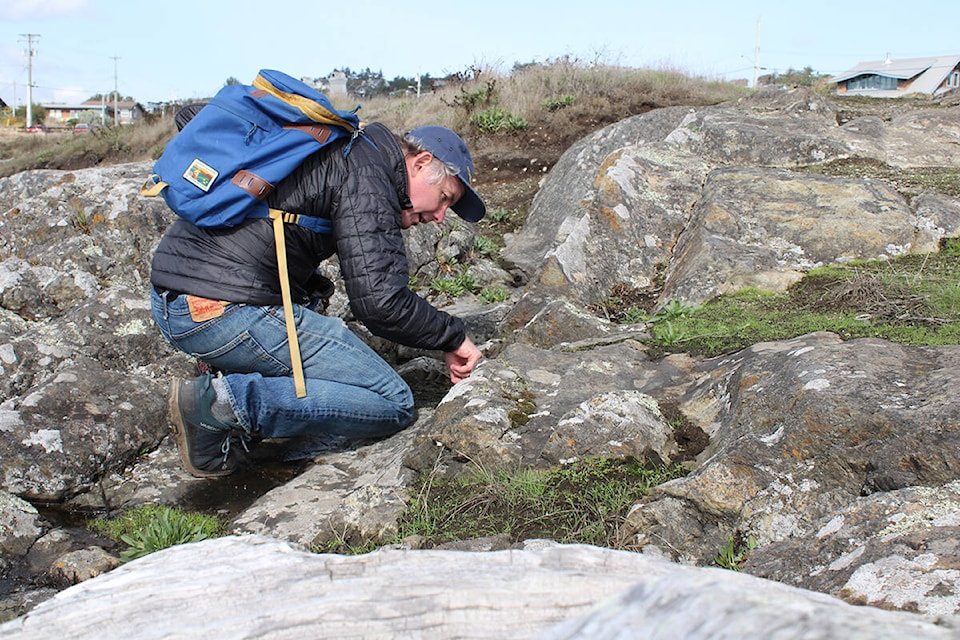As people walk along Greater Victoria’s coastline right now, most probably don’t realize that the tiny green specs underneath the soles of their shoes are plants found nowhere else in the world.
Some species, to the untrained eye, just look like a small, generic piece of grass or clover. But as Brian Starzomski presses the lens of his necklace magnifying glass to his eye and basically puts his nose in the Harling Point dirt, he’s peering into another world.
It’s hard to understand unless you have a look for yourself. At first, it’s a blur. “Go a little to your right,” Starzomski says, and by a little, he means less than a centimetre. Then suddenly the lens view changes like a camera coming into focus and staring back is a bulb spotted with countless, tiny, glimmering emeralds.
The plants dot the earth around a path along Harling Point’s rocky shore in Oak Bay, which Starzomski – a biodiversity expert who specializes in threatened species – says is home to the highest density of rare plants of anywhere in Greater Victoria. As the fall rains return, he says the Island’s “second spring” begins and endemic plants start their months-long regrowth before they fully bloom come winter.
“A lot of plants here adapted to start growing very slowly around this time of year as the rains start,” the University of Victoria associate professor says. “This is a special, special place in Canada.”
He steps methodically along the thin oceanside path and sticks to leaping from rock to rock where possible, before reaching an opening.
“This is it, from here to where the bushes start,” he says, pointing to a clearing that’s maybe 30 square meters in size. “This is one of the most important places for rare plants in Canada.”
Some of the unique species starting to bud there include bear’s-foot sanicle, Macoun’s meadowfoam, Texas balloonwart and Victoria’s paintbrush. They’re what, Starzomski says, some like to call “nature’s Mona Lisa.”
“They’re this beautiful creation of nature. They represent this habitat that’s very rare – this place that’s wet in the winter, super dry in the summer – it relies on these seeps (in the rock) that are very rare,” he says. “It’s reliant on those habitats and tells us those habitats still exist.”
These species, and others such as camas, thrived while the Lekwungen-speaking people managed the landscape since time immemorial with controlled burns at very specific times of the year – like in the spring before it got too dry, Starzomski says. But then came settlers who scrapped those practices and ever since the unique plant habitats along the south Island’s coast have been replaced by luxury homes and development. Reduced to just the last few patches at the Oak Bay point, the species face other threats like eroding ocean banks, walkers unknowingly trampling the tiny treasures and the invasive species that now dominate the area.
READ: Garry oaks, camas reveal agricultural impacts of colonialism on Vancouver Island
Starzomski stops and kneels down where the rock has formed a shallow gully, creating a vernal pool (puddle in the rock) where Macoun’s meadowfoam has started to creep out of the inch-deep soil.
“In the whole world, this is only found right here … and under your foot,” he says, before kindly asking to move onto the rock.
The plants that remain have shown they’re robust, but the biologist says moderate sea-level rise and increased sightseers could see species like the meadowfoam be wiped from the landscape within a quarter-century. He still wants people to go experience and appreciate the beauty of Harling Point but said moving some foot traffic away from the fragile vegetation would be a big help.
In terms of assisting conservation, he suggests signage explaining what an important place this is in Canada for endangered and threatened species. “It’d be a shame to see it damaged more.”
Looking out at the water from Harling’s rocky hilltop, Starzomski realizes what he’s talking about isn’t like taking in a giant redwood forest or humpback whales that he’s witnessed from that very spot. But metres away is an area not much larger than a cubicle, housing maybe 1,000 stems of a species found no place else on Earth.
“You see these big, obvious endangered species, but really the rarest, most endangered species are actually these tiny little things because this is it for their habitat.”
READ: Environment ministry cracks down on dogs to protect migratory birds in Greater Victoria
Do you have a story tip? Email: jake.romphf@blackpress.ca.
Follow us on Twitter and Instagram, and like us on Facebook.
